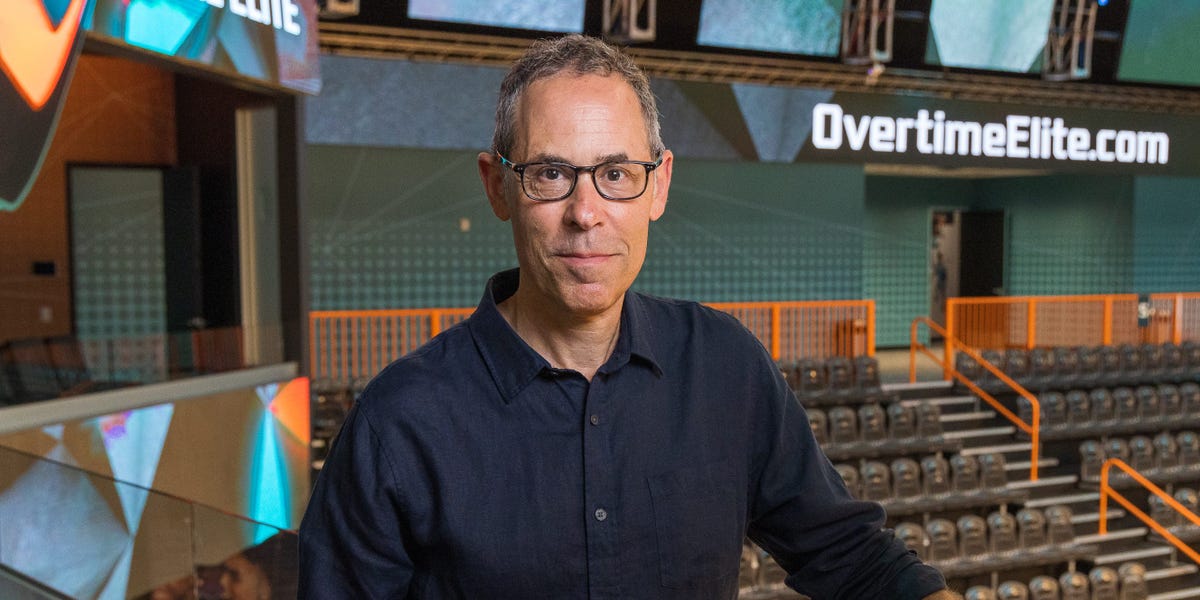Overtime has gained a big following with young sports fans, first as a distributor of high-school sports videos and then as a producer of its own shows and operator of its own sports leagues.
Now, it’s building a big business with advertisers that want to reach its audience.
This year, Overtime is on track to make $100 million based on deals that are locked in, a 40% year-over-year increase. It said some 80% of that comes from advertisers. Across its leagues, top sponsors include GMC, State Farm, and Adidas. The rest comes from merchandise — an eight-figure business — and sports rights fees from Amazon Prime Video. Amazon pays Overtime to stream its Overtime Elite basketball league, which the company said mainly compensates its players through scholarships.
Cofounder and CEO Dan Porter credited Overtime’s growth to its 100-million-plus social following, its full-fledged sales organization under CRO Rich Calacci, and the formation of its own sports leagues.
“We have three-year sponsorship deals with major brands,” Porter said, referring to Overtime’s league deals. “It puts us in the place where our revenue starts to look more like the NBA or the NFL.”
For example, GMC and C4 Energy drink pay Overtime to sponsor its Overtime Elite practice courts and Overtime Boxing ring, respectively. Their names get seen when people go through the arenas and when videos of the action go out on social media. Overtime also sells sponsorships and integrations around short videos that air on Instagram and TikTok. All in, the company said it’s done business with 180 brands.
Overtime has met an advertiser need
Overtime is a rare media company that’s captured the attention of young fans who are less likely than their parents to watch live sports on TV but who advertisers are eager to influence. As evidence of its resonance with fans, Porter pointed to the fact that Overtime now sells team-branded apparel in addition to Overtime-branded merch.
Megan Marks, Dentsu Media US’s VP of social partnerships and innovation, has several clients across major categories like consumer products, automotive, and fast food working with Overtime. She said Overtime is unusual in that it’s both a content creator and sports league, and targets young consumers in a way that’s brand-safe and doesn’t alienate millennials.
“They live in this unique spot,” she said. “They have a very captive Gen-Z audience. When you have more scale than almost every NFL team, that’s a pretty good sign.”
Its young audience also poses some limitations. That can take Overtime out of the running for certain big sports ad categories like beer and alcohol and credit card companies, though Overtime said 70% of its audience is now over the age of 21. Overtime also faces competition for ad dollars from college sports, NIL deals, and particularly this year, the Summer Olympics.
The company has started making inroads with some advertisers that generally aim at the higher end of Overtime’s age range, though. With auto companies like GMC, it’s offered a way to reach 22- or 23-year-olds who are thinking about buying car insurance or getting their first car.
“We own an audience segment,” Porter said. “Owning that demo that’s top of funnel for lifetime buying relationships I think has been really powerful for us.”
Porter, a former exec at talent giant Endeavor, started Overtime in 2016 with Zack Weiner, who also worked at the agency. It’s raised $250 million in total funding, most recently raising a Series D round of $100 million in 2022 led by Liberty Media Corp. A fundraising pitch deck that BI obtained in 2021 said Overtime was projected to grow to $200 million in annual revenue in three years through sponsorships and media rights, which is substantially greater than its projected 2024 revenue.
An Overtime rep told BI the deck was a “rough first draft” and “not a final go-to-market deck nor signed off by our investors or board.”
Overtime is eyeing more media rights
Porter continues to see media rights growth in Overtime’s future. The company now has four sports leagues, including men’s and women’s basketball, seven-on-seven football, and boxing.
He also sees more opportunity to complement its games sports rights with more shows like “One Shot: Overtime Elite,” an unscripted series showcasing the basketball league’s young players that airs on Prime Video. (Season 2 is coming in September.)
“Every sports league in America wants its ‘Drive to Survive,'” he said, referring to the Netflix hit series about Formula 1 racing. And he’s bullish on women’s sports, both on its Overtime Select women’s basketball league and partnering with athletes like WNBA star Breanna Stewart who’s advising the league.
“The No. 1 thing is, we have to grow fandom,” he said. “There aren’t 50 million people watching … If we continue to grow our audience so that there are more people watching our games than are watching a regular season game from one of the big four or five leagues, we’re going to be in a situation where we can accomplish that.”
February 29, 2024: An earlier version of this story misstated Overtime’s projected 2024 revenue growth and audience age, which were provided by the company. It expects to grow by 40% year-over-year, not 30%; and 70% of its audience is over age 21, not 50%.
This story has been updated to clarify that many of Overtime Elite’s players are on scholarships rather than being paid, the company said.
Read the full article here





